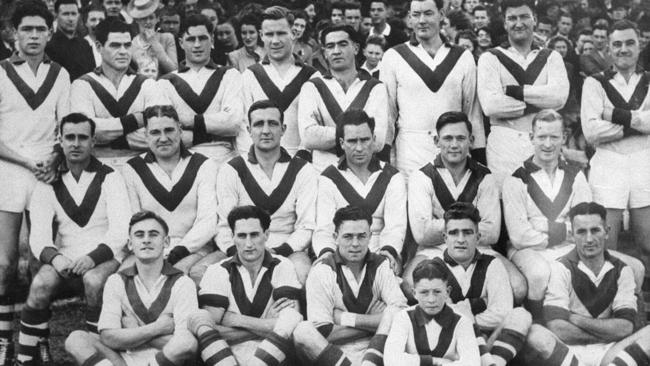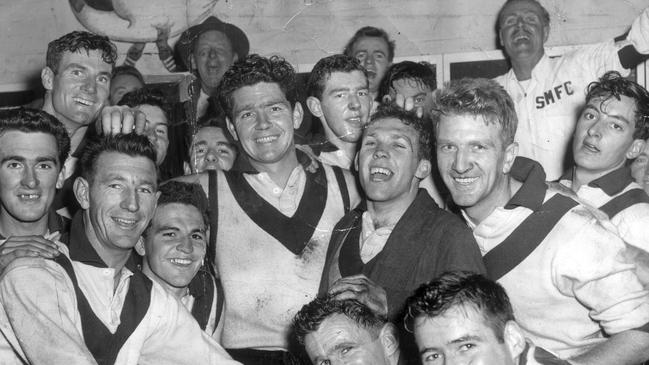The Swans helped found footy, then made our game truly national
South Melbourne was a founding member of both the VFA and the VFL, but was sacrificed to propagate Aussie rules in enemy territory. Meet the Swans, before the team swanned to Sydney.

Sydney
Don't miss out on the headlines from Sydney. Followed categories will be added to My News.
South Melbourne struggled for decades before the VFL transplanted the club to Sydney in 1982.
Long before the big shift north, South Melbourne was part of the bedrock of footy as a foundation member of the VFA and the VFL.
As the 1980s dawned, with debts mounting and years of underachievement behind them, there was no room for sentimentality in dealing with the Swans.
In Sydney, the Swans found success once again, but there was much for supporters to be proud of before the VFL swung the axe despite South Melbourne’s lack of on-field success.
ORIGINS
Football teams existed in South Melbourne and Albert Park as early as 1862, but the South Melbourne Football Club was formed in June 1874 following a meeting at the Temperance Hall in Napier Street.
Eventually, they adopted a white jumper with a red sash that earned the team the nickname Bloodstained Angels, or simply the Bloods alongside the less colourful moniker, the Southerners.
The club was admitted as a junior member of the VFA when it formed in 1877 and attained senior membership two years later.
It became an early power side when it merged with Albert Park in 1880.
The 1880s were the club’s first golden period. It was runner-up to Geelong in 1881, took out the premiership in 1881, came second to Geelong again in 1883, won the 1885 flag, went down to Geelong again in 1886 then won three in a row in 1887, 1888 and 1889.
The Bloods also figured in the first true grand final.

The VFA premiership was traditionally handed to the club that finished on top of the ladder and, in the event that two teams won the same number of matches, they were separated by goals scored.
When South and Collingwood tied on both measures in 1896, a grand final was required to separate them.
The Magpies won six goals to five.
It was the last VFA match for both teams. The two clubs, along with Carlton, St Kilda, Geelong, Essendon, Fitzroy and Melbourne formed the VFL the next year.
GOLDEN YEARS
South Melbourne appeared in its first VFL grand final against Fitzroy in 1899, but Fitzroy won the match — its second premiership on the trot.
The Bloods went down to Carlton by five points in the 1907 grand final.


It wasn’t until 1909 that the Bloods broke through with a two-point win over the Blues, the decision to appoint Charlie Ricketts as the team’s first official coach (captain coach, in fact) paying instant dividends.
Ricketts booted one of four goals in the match, with singles to Len Mortimer, Alf Gough and Bert Franks.
1909: BLOODS STAR IN OLDEST SURVIVING VFL FILM
The team squandered opportunities to win flags in 1912 and 1914, losing to Essendon by 14 points and Carlton by six respectively, but won the 1918 premiership with a five-point win over Collingwood.
Chris Laird and Gerald Ryan led the way with three goals each before a crowd of more than 39,000 people.
It would take 15 more years for South Melbourne to emulate the feat.
South made the finals in 1923 and 1924 but failed to get to the grand final despite the efforts of high-profile recruit Roy Cazaly, who joined the team in 1920 after 99 games with St Kilda.
South’s last golden period was during the 1930s, when strong recruiting from Victoria and interstate led the team to a fresh flush of success.


Jack Bisset was captain of a team that included goalkicking legend Bob Pratt, West Australians Bill Faul, Bert Beard, Brighton Diggins, John Bowe and Jim O’Meara, South Australians Wilbur Harris, Jack Wade and Ossie Bertram and Tasmanians Frank Davies and Laurie Nash.
An artist at the Herald and Weekly Times, publisher of the Herald Sun, dubbed the team the Swans after the WA faunal emblem, such was the western influence on the side. The name stuck.
It didn’t hurt that Albert Park Lake, right beside South Melbourne’s Lake Oval, was full of swans.
Bisset as captain-coach led the Swans to four consecutive grand finals from 1933 to 1936 but the side brought home only one flag — in 1933, it’s last.
Bob Pratt was the spearhead that day with three of the Swans’ nine goals to defeat Richmond by a handsome 42 points.
HOW WAR, MONEY ENDED UNIVERSITY’S VFL YEARS



Pratt booted 150 goals, a record equalled by Hawthorn’s Peter Hudson in 1971 but never beaten.
The Swans went down to the Tigers in 1934 and Collingwood in 1935 and 1936.
Pratt missed the 1935 grand final. He was clipped by a truck as he got off a tram the day before the game and had to withdraw.
After 1936, South Melbourne crashed out of finals contention, winning the wooden spoon in 1938 and 1939 and with a brief finals appearance only in 1942, before going down to Carlton in the infamously spiteful 1945 “bloodbath” grand final.
It was a game marked by king hits, all-in brawls and extraordinary violence both on the field and in the stands.
With the MCG still in war service, the match was played in wet, muddy conditions at Princes Park — a factor that didn’t hurt the Blues at all.
SAINTS FANS EARN HALOS IN DECADES OF STRUGGLE

Carlton captain Bob Chitty, one of the league’s most feared hard men, belted Swan Ron Clegg in the second quarter, sparking a series of violent incidents that involved players, officials, umpires and police.
Carlton came out on top 13.15 (103) to 10.15 (75). Ten players were reported, and seven were rubbed out for a total of 69 matches.
SLOW DEATH AND RELOCATION
From then on, the Swans travelled a long dark road.
Although the Swans came close to a finals berth in 1952, they did not see finals action between 1945 and 1970.



While match success was elusive, the Swans fielded many champions and boasted a flood of Brownlow medallists including Ron Clegg (1949), Fred Goldsmith (1955), Bob Skilton (1959, 1963 and 1968) and Peter Bedford (1970).
Coaches in this period included Clegg, Skilton, former Carlton premiership player Jack Hale, former captain Herbie Matthews, premiership player and former captain Laurie Nash,
Melbourne premiership player Noel McMahen and Alan Miller, who took the reins in 1967 and ‘68 without having ever played a VFL match.
Nothing worked, and the parlous state of South Melbourne’s finances and the shrinking population of its increasingly industrial inner suburban recruiting district made it more difficult for the club to attract and keep talented players.
WHY THE HAWKS TOOK SO LONG TO FLY IN THE VFL

HOW COLLINGWOOD STIRS EMOTIONS
One of the bright spots in that otherwise dim era was Skilton, who also won nine best-and-fairest awards in his time at the Swans.
An image of Skilton with two black eyes caused by a series if facial fractures from savage collisions in separate matches in 1968, adorned players’ room wall at the Lake Oval well into the ‘70s as an inspiration to the side.
The Swans’ fortunes turned around briefly in 1970, the year after legendary Melbourne coach Norm Smith moved to the Lake Oval, coming fourth in the home-and-away season.



But 104,000 people watched St Kilda wipe the floor with South Melbourne with a 53-point victory.
Skilton, the captain, who has said he’d trade his three Brownlows just to have played in a grand final, regards this appearance as the pinnacle of his footy career.
Expectations were high in 1971 but the Swans were outgunned and under-performing, crashing to the wooden spoon in 1971 and second last in 1972. Smith resigned.


Two more wooden spoons followed, in 1973 and 1975, before another master of the game, triple Brownlow medallist and St Kilda and Richmond premiership player Ian Stewart took the reins as coach in 1976, just months after his retirement from the game.
Stewart led the team to eighth place in 1976 and into the finals in 1977, the team romping home with four wins out of the last six rounds to scrape into the final five and with 1977 Brownlow medallist Graham Teasdale, a struggling forward at the time, switched into the ruck by Stewart.
Barry Round, John Rantall, a pre-Bomber Terry Daniher, Peter Morrison, Mark Browning and Teasdale were among the best in the club’s elimination final against Richmond, but the Tigers prevailed by 34 points.
Stewart was lured to a disastrous season with Carlton in 1978, returning to the Swans in 1979, but the magic had gone.
THE GREATS WHO SHAPED THE BOMBERS




By then, Swans management and the league were beginning to flirt with the idea of relocating South Melbourne, deep in debt and with no prospect of a white knight to rescue the side.
Barry Round won the Brownlow in 1981 but for the club, it was the end.
Crippled with debt and with so little on-field success since 1945, the VFL took over management of the club and allowed the team to move its 11 home games to Sydney in 1982 with a loan of $400,000 to relieve its financial pressure.
By 1983, the side was known as the Sydney Swans.
For the fans of the red and white that remained, the years since have been much more successful, but the relocation was a sad end to one of the founders of football.
SOUTH MELBOURNE
VFL Premierships: four (the last in 1933), runner-up eight times
Longest serving captain: Bob Skilton — 156 games from 1963 to 1971
Longest serving coach: Ian Stewart — 111 games from 1976 to 1977, 1979 to 1981
Longest serving player: John Rantall — 260 games from 1963 to 1972, 1976 to 1979)
Most goals: Bob Pratt, 681 goals from 1930 to 1939, 1946
Brownlow medallists: Herbie Matthews, 1940; Ron Clegg, 1949; Fred Goldsmith, 1955; Bob Skilton, 1959, 1963 and 1968; Peter Bedford, 1970; Graham Teasdale, 1977; Barry Round, 1981


